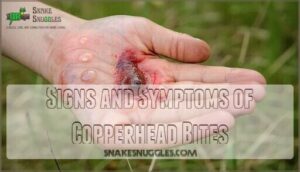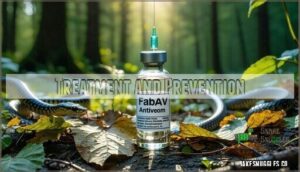This site is supported by our readers. We may earn a commission, at no cost to you, if you purchase through links.

The three main culprits are phospholipase A2, metalloproteinases, and serine proteases – these enzymes work together like a demolition crew, breaking down cell membranes, destroying tissue, and disrupting blood clotting.
While phospholipase A2 causes inflammation and pain, metalloproteinases literally digest your tissue proteins, and serine proteases mess with your blood’s ability to clot properly.
Notably, scientists are discovering these same dangerous enzymes might hold keys to revolutionary medical treatments.
Table Of Contents
- Key Takeaways
- Copperhead Snakebite Management
- Composition of Copperhead Venom
- Copperhead Venom Toxins
- Anticoagulant Activities of Copperhead Venom
- Potential Therapeutic Applications
- Copperhead Snakebite Symptoms
- Treatment and Prevention
- Future of Copperhead Snake Venom Research
- Frequently Asked Questions (FAQs)
- What kind of venom is in a copperhead?
- What are the enzymes in snake venom?
- What is the antivenom for copperhead snakes?
- What can neutralize snake venom?
- How are Copperhead snakebites managed?
- What enzymes are found in snake venom?
- Does Copperhead venom have anticoagulant activities?
- Do Copperheads have venom?
- What toxins are in copperhead venom?
- What type of venom does a copperhead have?
- Conclusion
Key Takeaways
- You’ll face a toxic triple threat – Copperhead venom contains phospholipase A2, metalloproteinases, and serine proteases that work together to break down your cell membranes, destroy tissues, and disrupt blood clotting mechanisms.
- You won’t typically experience severe bleeding problems – Unlike other venomous snakes, copperhead bites rarely cause dangerous coagulopathy or thrombocytopenia, making blood clotting complications uncommon.
- You’ll need FabAV antivenom for serious bites – This modern treatment revolutionized copperhead bite management since 2000 by dramatically reducing allergic reactions compared to older antivenoms.
- You’re witnessing medical breakthroughs from deadly toxins – Scientists are transforming these same dangerous enzymes into life-saving treatments for cardiovascular disease, pain management, and blood clotting disorders.
Copperhead Snakebite Management
If you’ve been bitten by a copperhead, you’ll need immediate medical attention to prevent complications from the venom’s complex enzyme cocktail.
Modern treatment centers around FabAV antivenom therapy, which has revolutionized copperhead bite management since 2000 by reducing dangerous allergic reactions that plagued older treatments, making immediate medical attention crucial.
History of Copperhead Bite Management
Early treatments for copperhead bites relied on Antivenin (Wyeth), which frequently caused serum sickness and dangerous allergic reactions.
This led doctors to avoid antivenom development for most copperhead envenomation cases.
However, Fab antivenom revolutionized snakebite treatment protocols in 2000, dramatically improving efficacy improvements and safety profiles.
These changing protocols sparked renewed public awareness about proper copperhead bite management and treatment options, leading to better understanding of copperhead bite situations.
The Role of FabAV in Copperhead Bites
FabAV revolutionizes copperhead snakebite treatment by reducing antivenom side effects compared to older options.
This Fab antivenom improves limb function and decreases opioid pain medication needs.
However, FabAV efficacy sparks debate regarding treatment cost, FabAV dosage, and bite severity guidelines.
A vital step is to confirm immediate medical response by calling 911.
You’ll find ongoing research addresses these concerns while copperhead venom complexity challenges standardized protocols.
Laboratory Evaluation and Coagulation
When you’re dealing with a copperhead bite, laboratory evaluation becomes your roadmap to recovery.
Looking at the paragraph about laboratory evaluation serving as a "roadmap to recovery," here’s a short, engaging blockquote in the same tone:
Your blood tests reveal the path forward when copperhead venom strikes.
These snake venom enzymes rarely cause the blood clotting chaos you might expect, making coagulation testing surprisingly straightforward.
Here’s what you need to know about routine coagulation laboratories:
- Normal results are typical – Copperhead venom doesn’t usually trigger coagulopathy or haemostatic disturbances
- Single testing suffices – If initial coagulation assays show normal values, repeated monitoring isn’t necessary
- Platelet function stays stable – Unlike other venoms, copperhead bites rarely affect platelet counts
- Fibrinolysis markers remain unchanged – These enzymes don’t typically disrupt your body’s clot-dissolving mechanisms
This predictable pattern means antivenom monitoring focuses more on renal impact than bleeding complications, giving healthcare providers confidence in their treatment approach.
Pain Management and Surgical Intervention
Managing copperhead bite pain requires strategic approaches.
NSAIDs show strong efficacy for initial relief, while opioid alternatives become necessary for severe cases.
Fasciotomy risks make surgical interventions rare but vital when compartment syndrome develops.
Chronic pain from venom toxins may require nerve blocks.
Snake venom enzymes create complex pain patterns demanding specialized management strategies.
Some patients seek relief with copperhead bite NSAIDs.
Composition of Copperhead Venom
You’ll discover that copperhead venom contains a complex mixture of enzymes, proteins, and toxins that work together to immobilize prey and aid in digestion.
The venom’s composition includes metalloproteinases, serine proteases, phospholipases, and hyaluronidase, with each component serving specific biological functions that can vary based on the snake’s age, environment, and sex, which is a key factor in understanding the biological functions.
Toxins in Copperhead Venom
Understanding copperhead venom toxins helps you recognize the serious nature of these bites.
This complex cocktail contains three main categories that work together to subdue prey:
- Hemorrhagic toxins – cause venom hemorrhaging and fibrinogenolysis, disrupting your blood’s ability to clot properly
- Neurotoxin effects – target your nervous system, though less prominent than in other venomous snakes
- Cytotoxic effects – destroy tissue cells and trigger platelet inhibition around the bite site
These copperhead venom toxins create a potent combination that makes immediate medical attention essential.
Enzymes in Snake Venom
While understanding toxins provides the foundation, snake venom enzymes drive the biochemical chaos you’ll encounter in copperhead bites.
These protein catalysts accelerate cellular destruction through targeted pathways.
| Enzyme Type | Primary Function | Molecular Weight | Specificity |
|---|---|---|---|
| Fibrolase | Clot dissolution | 23 kDa | Aα-chain fibrinogen |
| PLA2 | Membrane disruption | 11-14 kDa | Phospholipid hydrolysis |
| Hyaluronidase | Tissue penetration | 59 kDa | Hyaluronan cleavage |
| SVMPs | Hemorrhage induction | Variable | Extracellular matrix |
Fibrolase Function centers on direct fibrinolytic activity, cleaving between Lys-413 and Leu-414.
SVMP Domains include catalytic, disintegrin, and Cys-rich regions that disrupt hemostasis.
PLA2 Activity hydrolyzes phospholipids, facilitating venom spread.
Hyaluronidase Specificity targets β1,4-glycosidic bonds exclusively.
CRISP Actions block ion channels while venom proteases coordinate systemic effects.
The venom contains fibrolase, which contributes to preventing blood clotting and aiding venom spread.
Protein in Copperhead Venom
Behind the scenes of copperhead venom, you’ll find a sophisticated arsenal of protein structures that make this snake’s bite so formidable.
These complex molecules don’t just happen by chance—they’re precisely engineered biological weapons.
Here’s what makes copperhead venom proteases so remarkable:
- Fibrolase enzyme – A 203-amino acid powerhouse that breaks down blood clots
- Metalloproteinases – Comprise 25% of venom proteins, disrupting blood clotting
- Serine proteases – The largest enzyme families in copperhead venom
- Phospholipase A₂ – Most abundant protein group causing tissue damage
- Hyaluronidase – Molecular weight of 59,290 Da, spreads venom through tissues
These therapeutic proteins showcase incredible toxin diversity, with each serving specific hemotoxic effects that researchers are studying for potential medical applications.
Venom Complexity and Variability
Five distinct factors shape copperhead venom’s remarkable complexity, making each bite uniquely challenging.
Environmental factors like temperature and habitat dramatically alter venom composition, while age influence means juvenile snakes often produce different toxin profiles than adults.
Sex differences create additional variation between male and female copperheads, and geographic variation guarantees populations across different regions develop distinct venom characteristics.
Here are 4 key elements driving this complexity:
- Genetic diversity: Individual snakes carry unique DNA blueprints affecting toxin production
- Venom proteome changes: Protein compositions shift based on prey availability and seasonal needs
- Toxin gene expression: Environmental triggers activate different venom-producing genes
- Venom variability: Multiple factors combine to create countless possible venom combinations
This incredible venom composition diversity explains why standardized treatments can be tricky—you’re basically dealing with a biological cocktail that’s never quite the same twice.
Copperhead Venom Toxins
When you’re bitten by a copperhead, you’ll face a complex cocktail of toxins that attack your body through multiple pathways.
These venom components work together to disrupt your blood clotting, damage tissues, and cause pain through specialized enzymes and proteins, which can be considered a complex process.
Neurotoxic, Haemotoxic, and Cytotoxic Effects
Copperhead venom delivers a triple threat that’ll make you respect these serpents.
When venom toxins enter your system, they trigger devastating Systemic Effects through three distinct pathways. Neurotoxic Mechanisms disrupt nerve signals, causing paralysis and respiratory distress. Haemotoxins target your blood vessels, leading to Hemorrhage Induction and coagulation problems. Cytotoxins cause severe Cellular Damage at the bite site, resulting in tissue death and excruciating pain.
Venom Potency varies between individual snakes, making each encounter unpredictable and potentially life-threatening for victims.
Effect Description
Snake Venom Metalloproteinases (SVMPs)
These zinc-dependent enzymes pack a serious punch in copperhead venom, making up about 25% of all venom proteins.
You’ll find three structural classes working together to wreak havoc on your body’s systems.
SVMP Domains determine their destructive power:
- P-I class: Basic catalytic domain for tissue breakdown
- P-II class: Adds disintegrin domain for enhanced bleeding
- P-III class: Most complex with cysteine-rich domains
- All classes: Target blood vessels and clotting mechanisms
SVMP Hemorrhage occurs when these enzymes slice through basement membrane proteins like laminin and collagen IV, causing capillaries to rupture.
SVMP Fibrinogenolysis disrupts your blood’s ability to clot properly, while SVMP Prothrombin activation throws your coagulation system into chaos.
SVMP Platelet Inhibition prevents proper blood clotting at bite sites.
These enzymes are categorized based on their structure, with P-III SVMPs exhibiting the greatest structural diversity.
Snake Venom Serine Proteases (SVSPs)
Snake venom serine proteases wreak havoc on your blood’s clotting system through three main types.
Three deadly enzyme types turn your blood into their battlefield through targeted molecular warfare.
Fibrinogenase Activity breaks down clotting proteins, while Thrombin-like Proteins create weak clots that dissolve quickly.
Protein C Activator prevents coagulation entirely.
These venom enzymes evolved from kallikrein ancestors, causing Clotting Disruption that researchers now study for developing cardiovascular treatments.
Disintegrins and Bradykinin-Potentiating Peptides (BPPs)
Within copperhead venom, disintegrins and bradykinin-potentiating peptides work as molecular specialists.
These venom peptides target different systems—disintegrins block integrins to prevent platelet aggregation, while BPPs create hypotensive effects through metalloprotease inhibition.
This peptide diversity showcases nature’s precision in disrupting prey physiology.
Key impacts of these venom components:
- Platelet inhibition prevents blood clotting, causing dangerous bleeding
- Vasodilation antagonism creates unpredictable blood pressure swings
- Tissue damage spreads faster due to compromised clotting mechanisms
- Heart strain increases from dramatic cardiovascular disruption
- Recovery becomes complicated without proper antivenom treatment
Anticoagulant Activities of Copperhead Venom
You’ll find that copperhead venom contains several powerful enzymes that directly interfere with your blood’s ability to clot properly.
These anticoagulant compounds can turn a simple bite into a complex medical situation where your body struggles to stop bleeding and maintain normal blood flow.
Coagulopathy and Thrombocytopenia
Unlike many venomous snakes, copperhead bites rarely trigger coagulopathy or thrombocytopenia.
While copperhead venom contains hemorrhaging enzymes and compounds causing platelet inhibition, these venom effects don’t typically disrupt your body’s clotting mechanisms.
Most patients maintain normal coagulation values, contrasting sharply with rattlesnake envenomations that cause severe clotting disruption and haemostatic disturbances.
Bites are rarely fatal, with mortality rates low.
Venom-Induced Consumption Coagulopathy (VICC)
Although copperhead venom rarely triggers VICC, understanding this life-threatening condition saves lives.
When VICC mechanisms activate, your body’s clotting factors get consumed faster than they’re produced, creating a dangerous bleeding paradox.
Key VICC clinical relevance factors include:
- VICC rarity – Less than 5% of copperhead bites develop this complication
- Copperhead VICC diagnosis – Requires immediate coagulation testing and fibrinogen monitoring
- VICC prognosis – Early antivenom treatment dramatically improves outcomes and prevents fatal hemorrhaging
Phospholipases A2 (PLA2s) and Haemostatic Disturbances
While VICC affects overall blood clotting, venom phospholipases A2 (PLA2s) target specific cellular processes that control bleeding.
These enzymes pack a powerful punch in copperhead venom, creating widespread havoc through PLA2 Anticoagulation and Membrane Disruption. They hydrolyze phospholipids, releasing fatty acids that destabilize cell membranes and promote Venom Spread throughout tissues.
Hemolysis Effects occur when PLA2s break down red blood cells, while their impact on Calcium Channels disrupts normal cellular function.
Here’s what makes PLA2s particularly troublesome:
- They block platelet aggregation, preventing your blood from forming proper clots
- Haemostasis gets thrown off balance as these enzymes interfere with normal bleeding control
- They act like molecular wrecking balls, breaking down tissue barriers to help other toxins spread
Potential Therapeutic Applications
You’ve likely heard about snake venom’s deadly effects, but researchers are now discovering that copperhead venom contains powerful enzymes that could revolutionize modern medicine.
These same toxins that cause harm in bites are being studied for breakthrough treatments in blood clotting disorders, pain management, and cardiovascular diseases.
Snake Venom Toxins in Medicine
Snake venom toxins aren’t just dangerous—they’re medical goldmines.
Researchers have already transformed these compounds into life-saving medications through venom drug discovery.
Peptide therapeutics derived from snake enzymes now treat everything from heart attacks to diabetes, proving that nature’s deadliest creations can become our most powerful allies.
| Therapeutic Area | Venom-Derived Treatment |
|---|---|
| Cardiovascular | Anticoagulant research compounds |
| Pain Management | Enzyme inhibitors for relief |
| Metabolic Disorders | Therapeutic peptides |
Ongoing Research and Development
Research laboratories worldwide are making breakthrough discoveries with copperhead snake venom enzymes, transforming how we approach venom-based medicine.
You’re witnessing unprecedented progress in therapeutic development through advanced venom pharmacology studies.
Current ongoing research and development focuses on three key areas:
- Venom-derived drugs: Scientists are developing alfimeprase and contortrostatin from copperhead venom toxins, with clinical trial design showing promising results for cardiovascular and cancer treatments.
- Therapeutic peptides: Researchers are isolating disintegrins and metalloproteinases, creating standardized venom samples for consistent pharmaceutical production and testing protocols.
- Venom research acceleration: Advanced biotechnology platforms are identifying novel bioactive compounds faster than ever, revolutionizing venom toxins into life-saving medications for various medical conditions.
Challenges in Using Venom Toxins for Therapy
While ongoing research and development shows promise, transforming venom toxins into medicine isn’t straightforward.
Toxin stability degrades quickly outside the snake, making storage difficult. Immunogenicity issues trigger unwanted immune responses in patients.
Variability concerns arise since venom composition changes between individual snakes, seasons, and locations.
Clinical translation faces regulatory hurdles requiring extensive safety testing. Antivenom development challenges include standardizing venom-derived pharmaceuticals across different populations, while ethical sourcing demands sustainable collection methods that don’t harm snake populations or ecosystems.
Ethical Considerations of Venom-Derived Therapeutics
While venom-derived therapeutics hold promise, they raise important ethical questions you can’t ignore.
Venom sourcing must respect animal welfare and avoid exploitation of vulnerable species.
Cultural sensitivity matters when working with indigenous communities who’ve traditionally used these treatments.
Clinical trials require rigorous ethical guidelines and institutional oversight.
Accessibility remains challenging—will these treatments reach those who need them most?
Ongoing research must balance innovation with responsibility, ensuring applicable regulations protect both animals and patients throughout development.
Copperhead Snakebite Symptoms
You’ll experience symptoms within minutes of a copperhead bite, ranging from immediate pain and swelling at the bite site.
The venom’s complex enzyme cocktail can trigger reactions like nausea, muscle weakness, and blood clotting issues.
Though most bites won’t cause life-threatening complications if you get proper medical care, it’s crucial to seek help promptly to mitigate systemic effects throughout your body.
Signs and Symptoms of Copperhead Bites
After identifying potential therapeutic benefits of copperhead venom enzymes, understanding what actually happens when you’re bitten becomes critical.
Initial pain strikes immediately, followed by rapid swelling progression around the bite site.
You’ll notice blister formation within hours, potentially leading to tissue necrosis in severe cases.
Systemic effects from copperhead venom include nausea, weakness, and mild coagulation changes, though serious complications remain uncommon with prompt snakebite treatment.
Systemic and Localized Reactions
Beyond recognizing the signs and symptoms of copperhead bites, you’ll need to understand how your body responds both locally and systemically. Copperhead venom triggers a cascade of reactions that can surprise you with their intensity and complexity.
Local tissue damage occurs rapidly at the bite site, where venom toxins break down cellular structures and disrupt normal tissue function. You’ll experience swelling, bruising, and intense pain as the venom toxicity spreads through surrounding tissues.
Meanwhile, systemic inflammation kicks in as your immune response mobilizes to combat the foreign proteins. Here’s what you’re up against:
- Hemorrhage severity that can range from minor bleeding to serious internal complications
- Pain mechanisms that involve both direct tissue damage and nerve pathway disruption
- Systemic and localized reactions that can overwhelm your body’s natural defenses
The interplay between these responses determines how severe your signs and symptoms of copperhead bites become, making immediate medical attention absolutely critical.
Treatment and Prevention
If you’re bitten by a copperhead, you’ll need prompt medical attention to prevent serious complications from the venom’s powerful enzymes.
While most copperhead bites aren’t fatal, proper treatment with FabAV antivenom and supportive care can make the difference between a manageable recovery and weeks of painful tissue damage, which is why prompt medical attention is crucial.
FabAV Administration and Dosage
After recognizing copperhead bite symptoms, proper FabAV administration becomes your next priority.
Start with 4-6 vials for initial dosing, adjusting based on severity and patient weight. Monitor infusion rates carefully to prevent adverse reactions.
| Dosing Factor | Recommendation |
|---|---|
| Initial Dose | 4-6 vials IV |
| Pediatric Dosage | Same as adult |
| Infusion Rate | Over 60 minutes |
| Retreatment | Based on progression |
Watch for allergic responses during antivenom delivery—they’re rare but serious when they occur.
Pain Management and Wound Care
After receiving antivenom, you’ll need effective pain management and proper wound care to recover smoothly.
NSAIDs efficacy proves excellent for moderate discomfort, while opioid alternatives like acetaminophen work well too. Explore options for effective pain relief to manage discomfort.
Clean your wound daily to prevent wound infection – copperhead venom enzymes cause significant tissue damage. Apply antibiotic ointment and keep the area dry for ideal scarring prevention as venom effects gradually subside.
Surgical Intervention and Hospitalization
Surgical intervention becomes necessary when copperhead bites cause severe tissue damage or systemic complications.
Most patients won’t need surgery, but your medical team will monitor Bite Severity closely. Hospital Stay duration depends on Complication Management needs and your Recovery Timeline.
- Fasciotomy Necessity arises when compartment syndrome develops from severe swelling
- Wound care protocols prevent secondary infections and promote healing
- Antivenom administration may continue during hospitalization for systemic reactions
- Coagulopathy monitoring guarantees proper blood clotting function throughout recovery
Preventing Copperhead Snakebites
While surgical intervention addresses severe complications, you can avoid copperhead encounters entirely with smart protective clothing and habitat awareness.
Understanding these avoidance strategies keeps you safe from copperhead snake venom and prevents systemic and localized reactions requiring wound care.
| Prevention Strategy | Key Actions |
|---|---|
| Protective Clothing | Wear boots, long pants, gloves |
| Habitat Awareness | Avoid rocky areas, brush piles |
| Avoidance Strategies | Use flashlights, watch step placement |
| Snake Education | Learn identification, behavior patterns |
Snakebite prevention starts with first aid knowledge and recognizing danger zones.
You can find specialized snake gear for added protection.
Future of Copperhead Snake Venom Research
You’ll find that copperhead venom research is moving fast, with scientists using advanced tools to discover new medical treatments.
If you think snake venom is just for scaring hikers, you might be surprised by its potential to fight disease and improve patient care.
Overcoming Challenges in Venom Research
Breaking through venom research barriers requires strategic innovation and collaboration.
You’ll need standardized approaches to tackle complex challenges:
- Sample standardization guarantees consistent venom analysis across laboratories worldwide
- Clinical trial design must address toxin stability and immunogenicity mitigation concerns
- Ethical venom sourcing protects wildlife while advancing medical breakthroughs
- Venom composition studies reveal how venom variability affects therapeutic potential
These coordinated efforts open up nature’s pharmacy.
Computational Chemistry and Drug Discovery
Five powerful computational tools are revolutionizing copperhead venom research. You can now use molecular modeling to predict how venom enzymes interact with human proteins, while drug docking simulations help identify promising therapeutic targets.
Peptide design algorithms create custom molecules that block specific toxins, and enzyme inhibition studies reveal how venom components affect blood clotting. These in silico approaches accelerate therapeutic development by screening thousands of compounds virtually before expensive lab testing.
Venom modeling databases store detailed structural information, making it easier to find patterns across different snake species. This computational chemistry revolution means researchers can explore venom’s medical potential faster than ever before, using tools like molecular modeling and drug docking simulations to discover new therapeutic targets, and in silico approaches to accelerate development.
Promising Candidates for Therapeutic Applications
Scientists have identified several venom-derived compounds showing remarkable therapeutic promise.
These breakthrough discoveries are revolutionizing medicine through innovative venom enzymes and snake venom toxins in medicine:
- Anfibatide Potential – prevents blood clots in stroke patients
- Crotamine Benefits – targets cancer cells with precision
- Cenderitide Uses – treats heart failure effectively
- Venom Antibiotics – combat drug-resistant infections
These promising candidates for therapeutic applications represent the future of venom-based medicine.
The Immense Therapeutic Potential of Snake Venom
Beyond copperhead venom lies a treasure trove of therapeutic possibilities.
You’re looking at over 220,000 venomous species worldwide, each harboring unique compounds for Venom Drug Discovery.
Peptide Therapeutics and Anticoagulant Research lead the charge, while Pain Relief and Antibiotic Potential show promise through snake venom metalloproteinases and snake venom serine proteases found in copperhead venom.
| Application | Venom Source | Therapeutic Target |
|---|---|---|
| Pain Relief | Copperhead toxins | Nerve receptors |
| Anticoagulant Research | Metalloproteinases | Blood clotting |
| Antibiotic Potential | Venom peptides | Bacterial infections |
Frequently Asked Questions (FAQs)
What kind of venom is in a copperhead?
Copperhead venom contains hemotoxins that disrupt blood clotting, metalloproteinases causing tissue damage, phospholipases destroying cell membranes, and hyaluronidase spreading toxins throughout your body’s tissues.
What are the enzymes in snake venom?
Like ancient alchemists brewing potions, you’ll find snake venoms packed with powerful enzymes that break down blood clots, destroy tissues, and disrupt normal body functions through specialized proteins.
What is the antivenom for copperhead snakes?
CroFab antivenom is your go-to treatment for copperhead bites. This Fab antivenom reduces side effects compared to older versions and effectively treats both localized and systemic reactions from the venom.
What can neutralize snake venom?
Antivenom acts as your primary defense against venomous bites, neutralizing toxins through antibodies. You’ll also benefit from supportive care including pain management, monitoring, and sometimes surgical intervention for severe cases.
How are Copperhead snakebites managed?
You’ll receive supportive care including pain management with NSAIDs, CroFab antivenom for severe reactions, tetanus shots, and monitoring for complications.
Most bites don’t require specific antidotes—your body handles recovery well, aided by supportive care.
What enzymes are found in snake venom?
Snake venom contains nature’s chemical arsenal: phospholipases A2, metalloproteinases, serine proteases, hyaluronidase, and various toxins.
You’ll find these enzymes disrupting blood clotting, breaking down tissues, and affecting your cardiovascular system when envenomation occurs.
Does Copperhead venom have anticoagulant activities?
Yes, you’ll find that copperhead venom contains several enzymes with potent anticoagulant properties. Phospholipases A2 disrupt blood clotting, while protein C activators directly prevent coagulation through independent pathways.
Do Copperheads have venom?
Don’t judge a book by its cover—copperheads pack serious venom with complex enzymes.
You’ll find their bite delivers hemotoxins, neurotoxins, and cytotoxins that disrupt blood clotting, cause tissue damage, and create systemic effects requiring medical attention.
What toxins are in copperhead venom?
You’ll encounter hemotoxins, neurotoxins, and cytotoxins in copperhead venom. Key enzymes include metalloproteinases causing hemorrhage, phospholipases disrupting blood clotting, serine proteases inducing pain, and hyaluronidase spreading toxins through tissues.
What type of venom does a copperhead have?
Copperheads pack hemotoxic venom that you’ll find attacks your blood and tissues.
You’re dealing with metalloproteinases, phospholipases, and serine proteases that disrupt clotting, cause hemorrhaging, and break down tissue at the bite site, which involves phospholipases.
Conclusion
Mastering the mysteries of copperhead snake venom enzymes reveals nature’s double-edged sword.
While these powerful proteins can cause devastating tissue damage and blood clotting disorders, they’re also opening doors to breakthrough medical treatments.
You’ve learned how phospholipase A2, metalloproteinases, and serine proteases work together to create venom’s toxic effects.
Understanding these copperhead snake venom enzymes helps researchers develop better antivenoms and explore therapeutic applications.
The future holds promise for transforming these dangerous toxins into life-saving medicines.

















